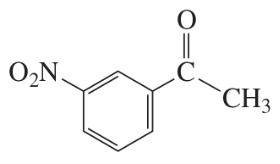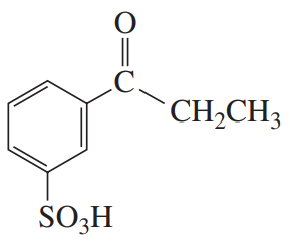 Back
BackProblem 4
Show the mechanism for the generation of the acylium ion if an acid anhydride is used instead of an acyl chloride for the source of the acylium ion.
Problem 5e,f
What is the major product of a Friedel–Crafts alkylation using the following alkyl chlorides?
e. (CH3)2CHCH2Cl
f. CH2=CHCH2Cl
Problem 10c
Draw a structure for each of the following:
c. o-nitroaniline
Problem 10d
Draw a structure for each of the following:
d. m-chlorobenzonitrile
Problem 11c
Draw a structure for each of the following:
c. 4-bromo-3-chloroaniline
Problem 12a
Correct the following incorrect names:
a. 2,4,6-tribromobenzene
Problem 12b
Correct the following incorrect names:
b. 3-hydroxynitrobenzene
Problem 12c,d
Correct the following incorrect names:
c. para-methylbromobenzene
d. 1,6-dichlorobenzene
Problem 12e,f
Correct the following incorrect names:
e. meta-bromotoluene
f. 6-ethyl-4-iodoaniline
Problem 14
Explain why fluorobenzene is more reactive than chlorobenzene toward electrophilic aromatic substitution but chloromethylbenzene is more reactive than fluoromethylbenzene.
Problem 15a
List the compounds in each set from most reactive to least reactive toward electrophilic aromatic substitution:
a. benzene, phenol, toluene, nitrobenzene, bromobenzene
Problem 15b
List the compounds in each set from most reactive to least reactive toward electrophilic aromatic substitution:
b. dichloromethylbenzene, difluoromethylbenzene, toluene, chloromethylbenzene
Problem 16a
Draw the resonance contributors for:
a. benzaldehyde
Problem 17e,f
What product(s) result from nitration of each of the following?
e. benzenesulfonic acid
f. cyclohexylbenzene
- For each horizontal row of substituted benzenes, indicate b. the one that is the least reactive in an electrophilic aromatic substitution reaction.
Problem 18
Problem 18a,b,c
Are the following substituents ortho–para directors or meta directors?
a. CH=CHC≡N
b. NO2
c. CH2OH
Problem 18d,e,f
Are the following substituents ortho–para directors or meta directors?
d. COOH
e. CF3
f. N=O
Problem 20a
What products are obtained from the reaction of the following compounds with one equivalent of Br2, using FeBr3 as a catalyst?
a.
Problem 20b
What products are obtained from the reaction of the following compounds with one equivalent of Br2, using FeBr3 as a catalyst?
b.
Problem 20c,d
What products are obtained from the reaction of the following compounds with one equivalent of Br2, using FeBr3 as a catalyst?
c.
d.
Problem 21a,b
Give the products, if any, of each of the following reactions:
a. benzonitrile + methyl chloride + AlCl3
b. phenol + Br2
Problem 21c,d
Give the products, if any, of each of the following reactions:
c. benzoic acid + CH3CH2Cl + AlCl3
d. benzene + 2 CH3Cl + AlCl3
Problem 22
a. Does a coupling reaction have to be used to synthesize p-dipropylbenzene?
b. Can a coupling reaction be used to synthesize p-dipropylbenzene?
Problem 23a
Show how the following compounds can be synthesized from benzene:
a.
Problem 23b
Show how the following compounds can be synthesized from benzene:
b.
Problem 24a
Show how each of the following compounds can be synthesized from benzene:
a. o-bromopropylbenzene
Problem 24d
Show how each of the following compounds can be synthesized from benzene:
d. p-chloroaniline
Problem 24f
Show how each of the following compounds can be synthesized from benzene:
f. m-xylene
Problem 24g
Show how each of the following compounds can be synthesized from benzene:
g. 2-phenylpropene
Problem 24h
Show how each of the following compounds can be synthesized from benzene:
h. m-bromopropylbenzene






